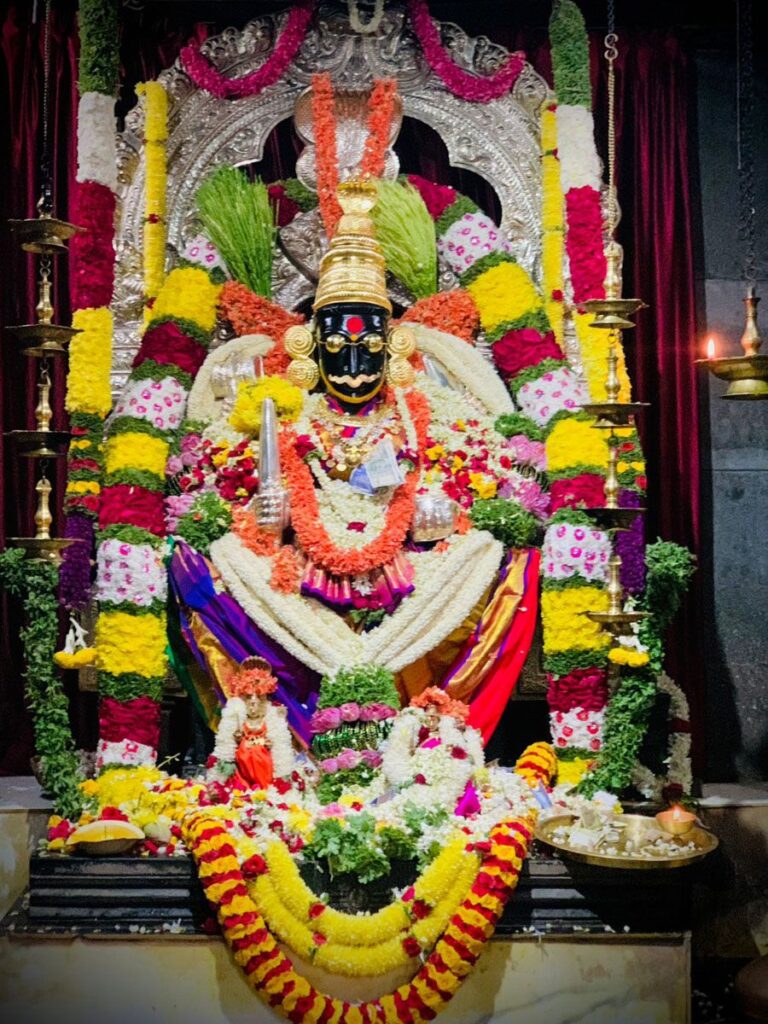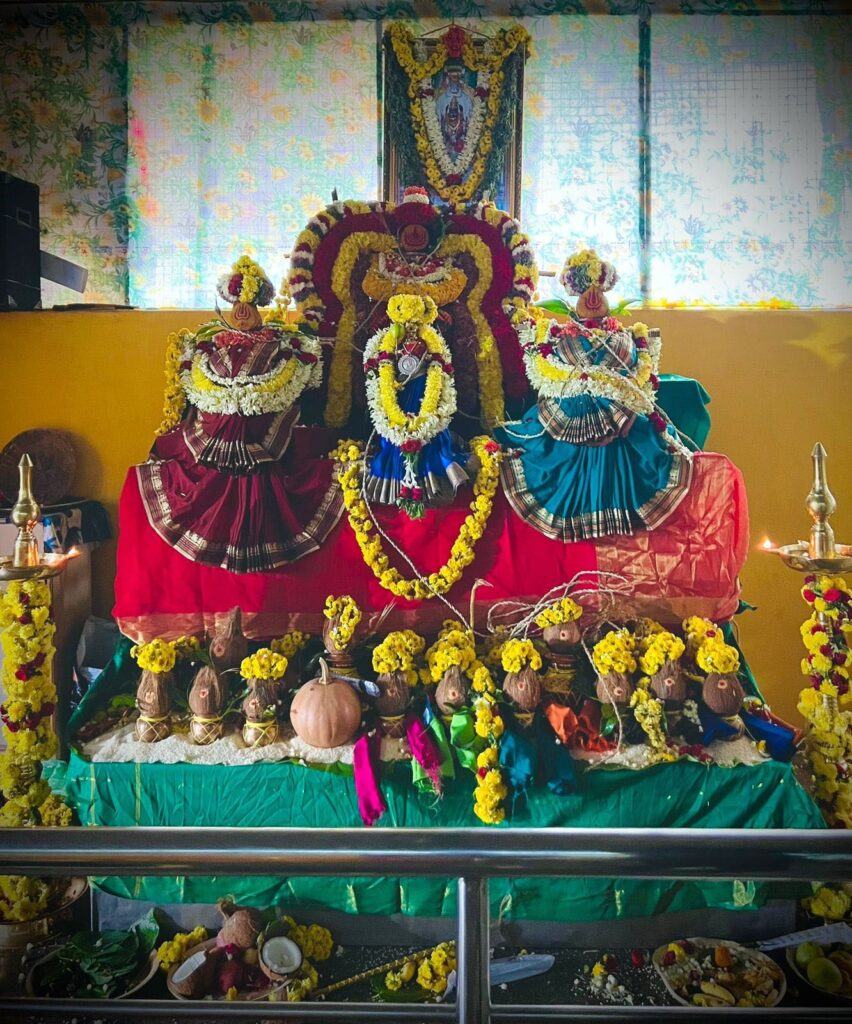Kabbalamma Temple Kanakapura
The Kabbalamma Temple Kanakapura is a Hindu temple dedicated to the goddess Kabbalamma, located in Maharajara Katte, Kanakapura, Karnataka, India. The temple is situated on a hilltop and is surrounded by lush greenery.

Contents
Story of Kabbalamma Temple Kanakapura:
While the exact age of the Kabbalamma Temple in Kanakapura, remains unconfirmed by inscriptions, legends weave a fascinating story around its origin:
The Weaver and the Serpent:
Once upon a time, a skilled weaver named Kabbala lived in the village. He was known for his beautiful handwoven fabrics and his kind heart. One day, while collecting flowers for a dye, he stumbled upon a large cave. Inside, he found a magnificent serpent guarding a treasure.
Frightened but respectful, Kabbala retreated, leaving behind an offering of flowers and a prayer for the serpent’s well-being. This act of respect touched the serpent, who appeared before Kabbala the next day. Instead of harming him, the serpent revealed it was a guardian of the land, protecting it from evil forces.
Birth of the Temple:
The serpent then entrusted Kabbala with a sacred task – to build a temple on the cave and worship it as a manifestation of the divine feminine energy, Shakti. Kabbala, overwhelmed with gratitude and devotion, readily agreed. He dedicated himself to constructing the temple, using his weaving skills to create intricate tapestries that adorned its walls.
Legacy of the Temple:
The temple, named after Kabbala, became a symbol of Shakti’s protective power and blessings. Over the years, devotees seeking prosperity, protection, and good health flocked to the temple, offering prayers and seeking the blessings of the resident deity.
Renewal and Significance:
Though the temple faced dilapidation over time, it was eventually renovated in 2015, allowing devotees to continue their traditions. Today, the Kabbalamma Temple stands as a testament to faith, respect for nature, and the enduring legacy of Kabbala, the weaver who earned the serpent’s trust and established a place of worship that continues to hold immense significance for the local community.
It’s important to note that, like many historical narratives, the story of the Kabbalamma Temple may have different versions and interpretations. However, it serves as a window into the cultural and religious beliefs that have shaped the temple’s significance for devotees.
Read More>> Nimishamba Temple Srirangapatna Mysore

Significance of Kabbalamma Temple Kanakapura:
Historical Significance:
- Ancient origins: The temple’s origins date back to ancient times, making it a historical landmark in the Ramanagara district, Karnataka.
- Guardian deity: The temple is dedicated to Goddess Kabbalamma, considered the guardian deity of the region, reflecting the deep historical and cultural roots of the area.
Religious Significance:
- Shakti worship: The primary deity, Kabbalamma, is a manifestation of Goddess Shakti, a powerful Hindu goddess representing strength and transformation. This attracts devotees who seek her blessings and power.
- Unique presence: The Kabbalamma Temple is the sole major Hindu temple serving surrounding villages, making it a vital center of faith and spiritual practice for a significant community.
Cultural Significance:
- Architectural marvel: The temple is not only a place of worship but also an architectural marvel with a unique structure and historical significance.
- Rituals and traditions: The temple is associated with unique rituals and traditions, like the practice of devotees allowing the resident bull to walk over them while seeking blessings. This showcases the diverse cultural practices associated with the temple.
Personal Significance:
- Devotional focus: Devotees visit the temple for various reasons, including seeking blessings for well-being, marital harmony, and protection from evil.
- Spiritual retreat: The temple’s serene location and peaceful atmosphere provide a space for spiritual reflection and rejuvenation for many.
Read More>> Sri Banashankari Temple Bengaluru

Myths of Kabbalamma Temple Kanakapura:
1. Seeking a home: Popular legend narrates that Goddess Kabbalamma, seeking a place to reside, arrived in the village of Kabbalu. She obtained permission from the local deity, Basaveshwara, to stay there. As a token of respect, the practice arose where the first puja offerings are made to Basaveshwara, followed by Goddess Kabbalamma.
2. Origin of the deity: Another legend suggests the temple might have been built to honor a snake revered as the village’s guardian deity. Over time, the snake transformed into the worship of Goddess Kabbalamma, reflecting the evolving beliefs and practices in the region.
3. The legend of the bull: A resident bull named Basaveshwara holds a significant place in the temple’s lore. Devotees, especially children, believe that lying down for the bull to walk over them brings blessings and fulfills wishes. This practice underscores the deep faith and unique traditions associated with the temple.
Read More>> Gavi Gangadhareswara Temple Karnataka
Kabbalamma Temple Timing and Rituals:
Timings:
The temple is open from 6:00 AM to 12:00 PM and 4:00 PM to 8:00 PM.
Rituals:
The Kabbalamma Temple is known for its unique rituals and festivals:
- Kabbalamma Jatre: This annual festival attracts a large number of devotees who participate in a vibrant procession and seek blessings from the deity.
- Offering to the Bull: A unique ritual involves devotees lying down on the floor and allowing the temple’s resident bull, considered a sacred representation of the deity, to walk over them. This signifies surrender and seeking divine favor.
- Prayers for well-being: Devotees come to the temple seeking blessings for various aspects of their lives, including marriage, health, and prosperity.
Read More>> 600 yrs Old Ghati Subramanya Temple
Places to visit near Kabbalamma Temple Kanakapura:
Mekedatu: This is a scenic spot located about 40 kilometers from the temple. It’s the confluence of the Arkavathi and Cauvery rivers, and offers stunning natural beauty. You can enjoy boat rides, coracle rides, and beautiful views of the river confluence.
Chunchi Falls: This is a beautiful waterfall located about 30 kilometers from the temple. The falls are especially spectacular during the monsoon season, and offer a refreshing escape from the heat. You can go for a swim in the pool below the falls, or simply enjoy the natural scenery.
Bilikal Rangaswamy Betta: This is a hill with a temple dedicated to Lord Ranganatha, located about 70 kilometers from the temple. You can trek up the hill to enjoy panoramic views of the surrounding area, or visit the temple for its religious significance.
Nature Adventure Camp: This is an adventure camp located about 60 kilometers from the temple. It offers a variety of activities such as trekking, cave exploration, rope climbing, and camping. It’s a great place to go for a fun and adventurous day out.
Read More>> Murudeshwar Temple Karnataka: India’s 2nd Massive Shiva Statue
FAQ:
General Information:
- Where is the temple located? The Kabbalamma Temple is situated in the village of Kabbalu, Kanakapura Taluk, Ramanagara District, Karnataka, India.
- What are the temple timings? The temple is generally open from 6:30 AM to 7:30 PM, with a brief closure between 7:30 PM and 8:00 PM.
- Is there an entry fee? No, entry to the Kabbalamma Temple is free. However, specific pujas or rituals might involve fees for participation.
Visiting the Temple:
- Is there a dress code? While there’s no strictly enforced dress code, dressing modestly is recommended. Opt for clothing that covers your shoulders and knees, and avoid overly revealing outfits to respect local customs and religious practices.
- What about footwear? Shoes are not allowed inside the temple. Designated areas outside the temple are available for storing your shoes.
- Can I take photographs? Photography is generally not permitted inside the temple. It’s best to inquire with the temple authorities before taking any pictures.
History and Significance:
- How old is the temple? The exact date of the temple’s origin remains unclear, with estimates suggesting its roots go back to ancient times.
- What is the significance of the temple? Dedicated to Goddess Kabbalamma, the temple holds immense importance for the surrounding community. It serves as the sole major Hindu temple for over 28 villages, making it a central point for religious practices and cultural identity.
Festivals and Events:
- What festivals are celebrated at the temple? The annual Kabbalamma Jatre attracts a large number of devotees who participate in the vibrant procession and seek blessings from the deity.
Additional Information:
- Are there any facilities available for tourists? Basic amenities like restrooms and drinking water are available within the temple complex. You might also find shops selling religious items and souvenirs.
- How to reach the temple? The temple is easily accessible by public transport, taxi, or rickshaw.
How to reach Kabbalamma Temple Kanakapura:
- By Road:
- If you are coming from Bangalore, you can take the Kanakapura Road (NH 948) towards the south.
- Follow the road through towns like Konanakunte, Vasanthapura, and Thalaghattapura.
- Continue on NH 948 until you reach Kanakapura.
- From Kanakapura, you may need to inquire locally or use a navigation app to find the specific location in Tigalarahalli.
- By Public Transport:
- Kanakapura is well-connected by buses from Bangalore. You can take a bus from Bangalore to Kanakapura and then arrange local transportation to Tigalarahalli.
- Alternatively, you can hire a taxi or use rideshare services from Bangalore to reach Tigalarahalli directly.
- By Train:
- The nearest major railway station is Bangalore City Junction. From there, you can take a taxi or bus to reach Kanakapura.
- There might be smaller railway stations closer to Kanakapura, and you can check for train services to those stations as well.
- By Air:
- The nearest airport is Kempegowda International Airport in Bangalore. From the airport, you can hire a taxi or use other transportation options to reach Kanakapura.
